Foot & Ankle
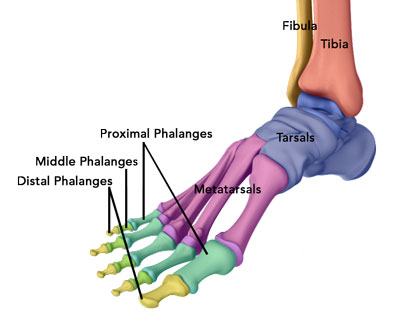

Anatomy of the Foot and Ankle
The foot and ankle are a complex joint involved in movement and providing stability and balance to the body. The foot and ankle consist of 26 bones, 33 joints, and many muscles, tendons and ligaments.
The ankle joint connects the leg with the foot and is composed of three bones: tibia, fibula and talus. The tibia or shinbone and fibula or calf bone are bones of the lower leg which articulate with the talus or ankle bone, enabling up and down movement of the foot.
Three bony bumps present on the ends of the tibia and fibula form parts of the ankle joint:
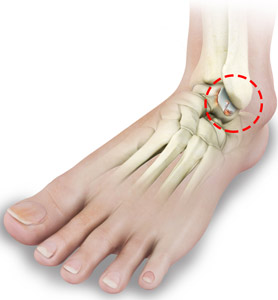
Foot and Ankle Arthritis
Arthritis is inflammation resulting from the degeneration of cartilage in the joint causing joint pain, swelling, and stiffness resulting in restricted movements. Arthritis of the foot and ankle joint can occur due to fractures, dislocation, inflammatory disease, or congenital deformity.
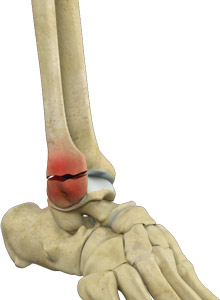
Ankle Fractures
The ankle joint is composed of three bones: the tibia, fibula and talus, which are articulated together. The ends of the fibula and tibia (lower leg bones) form the inner and outer malleolus, which are the bony protrusions of the ankle joint that you can feel and see on either side of the ankle. The joint is protected by a fibrous membrane called a joint capsule, and filled with synovial fluid to enable smooth movement.
Ankle injuries are very common in athletes and in people performing physical work, often resulting in severe pain and impaired mobility. Pain after ankle injuries can either be from a torn ligament and is called an ankle sprain or from a broken bone which is called an ankle fracture. An ankle fracture is a painful condition where there is a break in one or more bones forming the ankle joint. The ankle joint is stabilized by different ligaments and other soft tissues, which may also be injured during an ankle fracture.

Achilles Tendon Rupture
The Achilles tendon is a strong, fibrous cord present behind the ankle that connects the calf muscles to the heel bone. It is used when you walk, run and jump. The Achilles tendon ruptures most often in athletes participating in sports that involve running, pivoting and jumping. Recreational sports that may cause Achilles rupture include tennis, football, basketball and gymnastics.
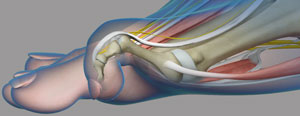
Common Toe Deformities
Hallux valgus is a common toe deformity in which the child's great toe is shifted laterally and lies over the second toe. The first metatarsal bone is deviated towards the medial side causing a prominence over the medial aspect of the metatarsophalangeal (MTP) joint. A fluid filled sac (bursa) may form over this prominence which may result in a painful bunion caused by continuous irritation and inflammation. Foot pronation (flat feet) may sometimes be associated with this condition.
The factors that cause hallux valgus include structural foot anomaly that may or may not be hereditary and use of narrow shoes that curl or fold the toes. Children having hallux valgus may not have any symptoms most of the times and do not require any treatment. Your doctor may advise shoes that have good amount of space for the toes and no heels. If there is flat foot then a shoe insert may help to prevent its progression. Surgery may be recommended only in severe cases.
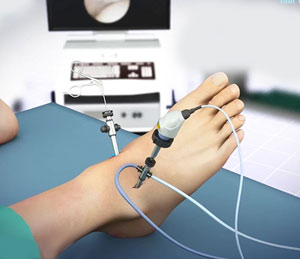
Ankle Arthroscopy
Ankle arthroscopy is a minimally invasive surgical procedure in which an arthroscope, a small, soft, flexible tube with a light and video camera at the end, is inserted into the ankle joint to evaluate and treat a variety of conditions.
An arthroscope is a small, fiber-optic instrument consisting of a lens, light source, and video camera. The camera projects an image of the inside of the joint onto a large screen monitor allowing the surgeon to look for any damage, assess the type of injury, and repair the problem.
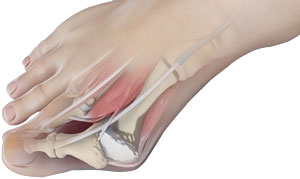
Bunion Surgery
A bunion, also known as hallux valgus, is bony prominence at the base of the big toe, which often results in pain, redness and rubbing in footwear. The first metatarsal bone abnormally angles outward towards the other foot from its joint in the midfoot. A bunion can change the shape of your foot, make it difficult for you to find shoes that fit correctly and worsen the symptoms if left untreated.

